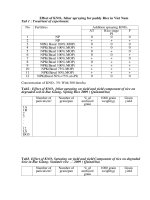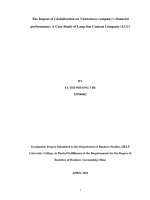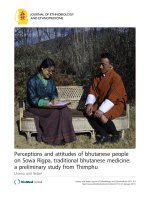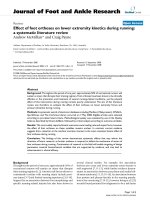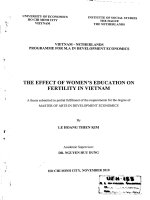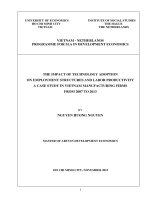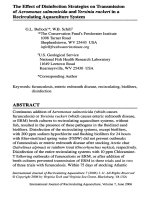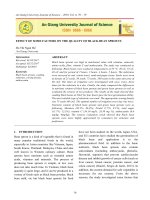Effect of sensory education on school children’s food perception: A 2-yearfollow-up study
Bạn đang xem bản rút gọn của tài liệu. Xem và tải ngay bản đầy đủ của tài liệu tại đây (273.32 KB, 11 trang )
Effect of sensory education on school children’s food perception: A 2-year
follow-up study
Sari Mustonen
*
, Reetta Rantanen, Hely Tuorila
Department of Food Technology, University of Helsinki, P.O. Box 66, FI-00014 University of Helsinki, Finland
article info
Article history:
Received 19 October 2007
Received in revised form 4 October 2008
Accepted 4 October 2008
Available online 11 October 2008
Keywords:
Child
Sensory education
Taste
Smell
Food perception
Neophobia
abstract
We studied the effect of sensory education on taste and odor awareness and food ratings in school children.
Second and fifth graders (n = 244, 7–11 years at the baseline) from two schools in Helsinki area participated
in the study. At the completion of the study at two years, the groups consisted of 96 (education, school one)
and 79 (control, school two) students. At baseline and in four follow-up measurements, both groups per-
formed six tasks: (1) free odor naming (five odors), (2) taste identification (six solutions), (3) descriptive
characterization of two breads, (4) ratings of the extent to which subjects paid attention to sensory prop-
erties of food, (5) willingness-to-try ratings of unfamiliar vs. familiar foods and (6) aided odor naming (five
odors, 10 verbal labels). Subsequently, the education group received two waves of sensory education: the
first wave comprised of 10 Classes du goût lessons and the 2nd of 5 lessons familiarizing the children with
different food categories. The second wave was performed only for 2/3 of the education group. The edu-
cated children improved their skills in identifying tastes and odors, and characterizing foods, while no dif-
ference was seen in the performance of the control group. However, effects of education were mainly
observed for the younger children only. Although the improvements were small and not always consistent
over the study period, their general direction was encouraging: the sensory education activated children’s
odor and taste perceptions and improved their ability to describe sensory properties of food.
Ó 2008 Elsevier Ltd. All rights reserved.
1. Introduction
Flavor preferences established early in life track into later child-
hood (Mennella, Pepino, & Reed, 2005). The information concerning
children’s use of their senses of taste and smell, and learning their
preferences, is still rather scarce. It is, however, well known that
children like sweet-tasting foods and beverages. Birch (1979) has
found that children under five years base their food preferences
on two dimensions: sweetness and familiarity. Thus, children’s food
preferences and dietary choices might be driven primarily by sen-
sory qualities of food, whereas adults tend to be more concerned
with the nutritional and health qualities of the diet (Drewnowski,
2000; Nicklaus, Boggio, Chabanet, & Issanchou, 2004).
A common belief is that children are more sensitive to smell and
taste stimuli than adults, although researchers have not been able
to show any difference in sensitivity (Guinard, 2001). The belief
may be a misconception due to children’s tendency not to accept
new or unfamiliar foods, called neophobia. Neophobia is a protec-
tive mechanism preventing animals and humans from eating what
could be harmful to them. At the same time it leads humans to
choose the familiar and safe food instead of new and unfamiliar,
potentially harmful food. Neophobia appears in all age groups,
but the strength of neophobia varies between individuals (Pliner
& Salvy, 2006). In children, strong neophobia is probably due to
the lack of earlier experiences on different foods (Birch, 1999), as
exposures to a large variety of unfamiliar foods can reduce the neo-
phobic reactions towards other novel, at least similar, foods (Birch,
Gunder, Grimm-Thomas, & Laing, 1998). Also Pliner, Pelchat, and
Grabski (1993) have shown that exposing humans to novel foods
can reduce their food neophobia. Thus, humans tend to widen their
preferences also to initially rejected foods, but they need a compel-
ling force to do so. According to Birch (1999), and Popper and Kroll
(2005), social influence may also help to reduce neophobia, espe-
cially in children. The present paper describes a sensory education
program that provides children social interaction with their peers
as well as increases their awareness of and curiosity towards foods.
Sensory education may act as the compelling force needed to
increase willingness to taste unfamiliar foods.
In industrialized countries, changing society and busy lifestyles
drive people to more convenient and, at the same time, to monot-
onous food choices and increased use of snack foods (Jahns,
Siega-Riz, & Popkin, 2001). The current lifestyle also acts as a main
barrier to planning regular and balanced meals in the family: par-
ents are busy and the need for convenience drives them more and
more often to feed their children with easy options like fast food or
snacks (Gillman et al., 2000; Haapalahti, Mykkänen, Tikkanen, &
0950-3293/$ - see front matter Ó 2008 Elsevier Ltd. All rights reserved.
doi:10.1016/j.foodqual.2008.10.003
* Corresponding author. Present address: Valio Ltd, R&D, P.O. Box 30, FI-00039
Valio, Finland. Tel.: +358 10 381 3047; fax: +358 10 381 3372.
E-mail address: sari.mustonen@valio.fi (S. Mustonen).
Food Quality and Preference 20 (2009) 230–240
Contents lists available at ScienceDirect
Food Quality and Preference
journal homepage: www.elsevier.com/locate/foodqual
Kokkonen, 2003). This kind of a change does not promote the adop-
tion of new food experiences (Carruth et al., 1998; Neumark-
Sztainer, Hannan, Story, Croll, & Perry, 2003). Instead, it leads chil-
dren and adolescents to repeatedly choose the same and familiar
foods, causing monotonous and unhealthy diet in the long run
(Veugelers & Fitzgerald, 2005). Because of this blunting trend, the
future generation may be unable to demand high quality or to have
the courage to try new, exotic foods. Therefore, it is important to
invent and develop new ways to encourage children to try different
foods and pay attention to the quality of foods. This may eventually
have beneficial effects on children’s diets in terms of greater vari-
ety and better quality of food.
In France, Puisais and Pierre (1987) developed and described
‘‘taste lessons” (Classes du goût). This education program for school
children has been used in several European countries, e.g. in Swe-
den (Hagman & Algotson, 2000). The program aims to teach young
children to become well-informed consumers with awareness of
the quality and differentiation of foods through their smells, tex-
tures and tastes. Children’s awareness is developed by awakening
their interest and curiosity towards foods by exercising their
senses. Although widely used, the evidence of the impact of the
education program is still rather scarce. To date, no systematic re-
search on the effects have been available in scientific literature.
Ton Nu (1995) has reported that, as a result of the program, chil-
dren’s interest in food quality increased and their ability to de-
scribe sensory properties of food improved compared to the
control group, but no measurements were conducted at the base-
line level. Thus, development in sensory awareness over time could
not be proven. Sune, Lacroix, and de Kermanec (2002) compared
children who attended the Classes du goût program with their
non-trained peers and adults in sensory characterization of choco-
late and found that despite the education, children described the
chocolate in their own way and adults in their own way.
In Finland, we started a 2-year follow-up study with school chil-
dren, representing two age groups (7–8 and 10–11 years), to track
the development of chemosensory awareness and food-related
perceptions influenced by the program. One-half of children re-
ceived up to two waves of taste lessons (first, a Finnish application
of Classes du goût program and second, activating lessons on main
food categories) and another half performing baseline and follow-
up measurements only. Two age groups were included to the study
to examine whether the possible effect of education would depend
on the age at which the lessons are attended. The education group
was further divided into two subgroups, as the second wave of
education was given only to 2/3 of the education group, to examine
whether the children would benefit from a prolonged education.
The effects of the sensory education were studied with (1) sensory
tests conducted in the laboratory and (2) background question-
naires on subjects’ food behavior that were sent to parents three
times during the follow-up period. This paper describes the results
of sensory measurements at the baseline and in the four follow-up
measurements, all conducted in the laboratory during two years of
time. The first education wave was expected to increase sensory
awareness, improve food description skills and increase the will-
ingness to taste unfamiliar foods. Due to the nature of the lessons
in the second education wave, it was expected to maintain the
interest in chemosensory perception achieved during the first
wave, and increase the interest in trying unfamiliar foods.
2. Materials and methods
2.1. Development and selection of the sensory instruments
A preliminary study was carried out during the autumn 2004 to
develop and select the sensory instruments for the proper study.
Three classes of third graders and three classes of fourth graders
participated in the preliminary study, testing different sensory
measurements (odor naming, taste identification, descriptive tasks,
etc). The tests were conducted twice, and between the sessions one
group of the children (N = 35) received a lesson on the sense of
taste, another group (N = 34) received a lesson on the sense of
smell and the third group (N = 40) received no lesson. Children par-
ticipating in the pilot taste lesson showed slight improvement in
their taste identification. No improvement was seen in the odor
naming abilities of the group receiving the olfactory lesson, but it
was expected that after a profound sensory education on tastes
and odors the effects would emerge. The descriptive abilities were
expected to improve due to the sensory education that included
descriptive tasks, although after the pilot lessons the only effect
was a decrease in the number of preference-related descriptors.
The willingness to taste unfamiliar foods was expected to increase
due to the tasting experiences and the overall increase of knowl-
edge on different foods during the sensory education. The tests that
seemed to have potential in showing education effects in the pre-
liminary
study
were chosen to the proper study (described in detail
below).
2.2. Subjects
In the proper study, 244 students (aged 7–11 years) from two
primary schools in Helsinki were recruited. The schools chosen
were approximately similar in size and their students had more
or less the same level of socio-economical background (between
middle and high). Of the students, 175 participated in all follow-
up measurements, and are therefore included in the data analyses.
In the beginning of the study, they were students at the second (7–
8 years) and fifth (10–11 years) grades in Viikki Teacher Education
School at Helsinki University (education group, n = 96) and Puistola
Primary School (control group, n = 79). The students from the first-
mentioned school were chosen to be the education group for prac-
tical reasons, as sensory lessons fitted into their curriculum. The
profiles of the subjects (grades and gender distribution) are shown
in Table 1. The drop-outs in the last follow-up measurement were
due to some of the students in the older group moving on to an
upper level of comprehensive school, and thus to a different sys-
tem or even to a new school.
2.3. Overview of the proper study
At baseline (January 2005), both groups performed sensory
tests, and subsequently, one group (education group) participated
in sensory education. The tests were conducted four times during
the two years’ period: after the first education wave (May 2005),
before and after the second education wave (January and May
2006, respectively) and finally in January–February 2007 (Fig. 1).
Additionally, a questionnaire was sent to the parents three times
during the follow-up period (results reported elsewhere).
The study protocol followed the ethical principles of sensory
testing in our laboratory, approved by the ethical committee of
Table 1
The study population. In the beginning of the study the children were 8-year-old
(second graders) and 11-year-old (fifth graders).
Group and grade N boys/girls N (2005–2006) baseline
and 1st–3rd follow-ups
N (2007)
4th follow-up
Education
2nd–4
th
19/22 41 38
5th–7th 30/25 55 38
Control
2nd–4
th
12/22 34 31
5th–7th 26/19 45 30
Total 87/88 175 137
S. Mustonen et al. / Food Quality and Preference 20 (2009) 230–240
231
the Faculty of Agriculture and Forestry. An additional approval was
applied as the subjects were minors (under 18 years of age). The
parents signed an informed consent before the study began. The
subjects themselves gave a verbal assent to participate.
2.4. Laboratory sessions
The measurements (lasting approximately 1.5 h) were con-
ducted in the sensory laboratory of the University of Helsinki (ex-
cept for the last session for the older group, which was performed
in the school auditoria). All measurements were made during the
school day (9 a.m. to 3 p.m.). One class at a time (N = 17–28) came
to the laboratory with a teacher and performed the tasks in a given
order in ten sensory booths or at a round table with screens pre-
venting visual interaction between the ten seats. During the ses-
sion, the places were switched for each task so that each subject
was placed in both the booths and at the round table. In each ses-
sion, the subjects performed six tasks in the following order: (1)
pleasantness ratings, intensity ratings, and free naming of five odor
stimuli; (2) taste identification of six aqueous solutions (sweet,
salty, bitter, sour, umami, and water); (3) descriptive characteriza-
tion of two breads; (4) ratings of the extent to which subjects paid
attention to sensory properties of food; (5) willingness to taste
unfamiliar (five in the baseline and first follow-up, seven in the
second-final follow-ups) and familiar (seven) foods (the procedure
adapted from that by Pliner, 1994), and (6) aided odor naming (five
odors, list of 10 verbal labels provided). Before every task, the sub-
jects were familiarized with the evaluation forms and scales. The
tasks are described in detail below. After the sessions, the subjects
were rewarded with small food gifts (lollipops, xylitol chewing
gums etc.), and in the end of the final session, they were invited
to make and consume their favorite ice cream portions using a
selection of ice creams, jam, sauce, nonpareils, wafer, and
decorations.
2.4.1. Sensory instruments
2.4.1.1. Free odor naming and ratings for pleasantness and intensity
(Task 1)
.
The test included five aqueous aroma solutions: straw-
berry, carrot, vinegar, cardamom, and vanilla (Table 2). The samples
(10 ml each) were presented in small brown glass vials coded with
five letters (Z, D, F, X, G) and the presentation order was random-
ized in five different ways for practical reasons. The same five or-
ders were used for each follow-up, without controlling the order
individually for each child. The subjects also rated the pleasantness
and intensity of each sample. The pleasantness was rated using se-
ven categories (1 = bad and 7 = good), extreme ends supported by
facial symbols, and the intensity was rated using seven categories
(1 = weak, 7 = strong). The purpose of these ratings was to maxi-
mize the attention paid to each sample. After ratings, the subjects
were asked to name each odor. If uncertain, they were asked to
guess. Table 3 shows the mean ratings of pleasantness and intensity
given to the aroma solutions at the baseline measurement.
2.4.1.2. Taste identification (Task 2). The test included aqueous solu-
tions of five taste stimuli (sweet, salty, sour, bitter, umami) and
water (Table 4). The solutions (approximately 15 ml each) were
presented in white plastic cups coded from 1 to 6. The presentation
order was randomized in six different ways. The labels of the tastes
were listed, and the subjects ticked the box they thought was the
correct answer. Umami was described as ‘‘umami (meaty)”. The
subjects compared the solution to plain tap water when they tried
to identify the taste. In case they did not identify the taste, they
were asked to guess.
2.4.1.3. Descriptive characterization of two breads (Task 3). The sub-
jects were presented with two bread samples in each session. All
breads were commercial Finnish breads (brand names in parenthe-
ses below) and represented different sensory properties. At the
baseline they were wheat toast (Reilu, Fazer Bakeries) and a whole-
January 2005
BASELINE MEASUREMENT
Sensory instruments
Questionnaire to parents
October-December 2004
PILOT TESTING
RECRUITMENT
Informed consent (parents)
1
st
WAVE OF SENSORY EDUCATION
April-May 2005
1
st
FOLLOW-UP MEASUREMENT
Sensory instruments
Questionnaire to parents
January 2006
2
nd
FOLLOW-UP MEASUREMENT
Sensory instruments
2
nd
WAVE OF SENSORY EDUCATION
(for 2/3 of the education group)
May 2006
3
rd
FOLLOW-UP MEASUREMENT
Sensory instruments
Questionnaire to parents
January 2007
4
th
FOLLOW-UP MEASUREMENT
Sensory instruments
Fig. 1. Flow chart of the experimental procedure of the study.
Table 2
Aqueous aroma solutions (dissolved in tap water) used in the free and aided odor
naming.
Free odor naming (Task 1) Aided odor naming (Task 6)
Aroma/Ingredient Concentration
(%, w/v)
Aroma/Ingredient Concentration
(%, w/v)
Vanilla
1
0.4 Pineapple
2
0.3
Cardamom
1
0.1 Cocoa
1
0.4
Strawberry aroma
1
0.15 Lemon
1
0.02
Carrot
2
(powder) 0.5 Onion
2
(powder) 0.4
Vinegar
3
33.3 Peppermint
1
0.15
Manufacturers: (1) Quest International, The Netherlands; (2) Givaudan, Switzer-
land; (3) Rajamäki, Finland.
Table 3
Mean ratings (SD) of pleasantness and intensity of the aroma solutions in the free
odor naming at the baseline (Task 1).
Aroma/ingredient Pleasantness (scale 1–7) Intensity (scale 1–7)
Vanilla 5.3 (1.8) 4.0 (1.6)
Cardamom 4.8 (1.7) 4.3 (1.6)
Strawberry 4.5 (1.9) 4.6 (1.5)
Carrot 3.3 (1.8) 4.6 (1.7)
Vinegar 2.1 (1.7) 5.5 (1.7)
232 S. Mustonen et al. / Food Quality and Preference 20 (2009) 230–240
meal rye bread (Real, Fazer Bakeries Oululainen); in the first fol-
low-up regular rye bread (Ruispuikula, Fazer Bakeries) and a sweet
loaf (Setsuuri, Fazer Bakeries); in the second follow-up dark loaf
(Maalahden limppu, Malax Limpan Ltd.) and grainy wheat toast
(Jyväinen IsoPaahto, Vaasan and Vaasan Oy); in the third follow-
up two premium breads, garlicky cheese ciabatta (Artesaani, Prim-
ula Oy) and grainy rye bread (Artesaani, Primula Oy); and in the
last follow-up measurement the subjects described the same
breads that were presented in the baseline measurement. The sub-
jects described separately the appearance, smell, taste and texture/
mouthfeel of both samples. They were told to avoid words relating
to preference. They rinsed their mouths with tap water between
the samples.
2.4.1.4. Ratings of the extent to which subjects paid attention to
sensory properties of food (Task 4). In this task, the subjects rated
the extent to which they paid attention to sensory properties
(appearance, odor, taste, texture) of food (scale: 1 = not at all,
2 = slightly, 3 = quite much, 4 = very much).
2.4.1.5. Willingness to taste unfamiliar vs. familiar foods (Task 5). The
subjects were presented with 12 (baseline and first follow-up) or
14 (other measurements) pictures of familiar (seven) and unfamil-
iar foods (five/seven) in color. The task was to identify which food
was in the picture. The subjects then got another booklet in which
the same foods were presented in black and white, with the name
of the food in the upper edge of each picture. They were asked to
reply yes/no to the following questions: (1) ‘‘Have you ever seen
this food before?” (2) ‘‘Have you ever tasted this food before?”
and (3) ‘‘Would you like to taste this food?” The first two questions
were used to check whether the foods actually were unfamiliar for
the children. Although the results were not analyzed individually,
the distributions strongly suggested that the foods expected to
be unfamiliar to the children actually were unfamiliar.
The familiar foods (rye bread, ice cream, blueberry, meat balls,
Edam cheese, carrot, chocolate cookie) were the same for each fol-
low-up point, but the unfamiliar foods were changed. At the base-
line and at the first follow-up, the unfamiliar foods were goat
cheese, lychee, sun-dried tomatoes, Naan bread, and frog legs. At
the second and third follow-up they were: squid, sheep milk
cheese, carambola, artichoke, couscous, kidney pie, and shiitake.
At the last follow-up they were: oyster, Camembert, pitahaya, avo-
cado, sweet potato, reindeer tongue aspic, and endive. Even if the
two successive follow-up measurements had the same pictures
of the unfamiliar foods, the familiarity status of each food did
not change as we instructed the children to answer ‘‘yes” only if
they had seen the food for real, not in a picture. The food pictures
were kept similar for two successive sessions to make the compar-
ison reliable. If the foods had been changed every time, the unfa-
miliarity may have changed because of the foods chosen, and not
for the reasons we were measuring. Yet, we had to change some
of the foods a few times during the study, to avoid familiarity
and boredom with the same foods.
The task was not performed by the older group in the last fol-
low-up session, as that session had a limited space and time frame
that required adjustments.
2.4.1.6. Aided odor naming (Task 6). The test included five aqueous
aroma solutions: cocoa, pineapple, lemon, onion, and peppermint
(Table 2). The aroma samples (10 ml each) were presented in small
brown glass vials coded with five letters (H, J, N, L, R) and the
presentation order was randomized in five different ways. The sub-
jects were asked to connect the odor (letter codes in the evaluation
form) to the correct label. They could choose from 10 labels, of
which five were correct. The labels (correct ones marked with
bold) were: black pepper, banana, cocoa, pineapple, onion, cinna-
mon, apple, orange, lemon, peppermint.
2.5. Sensory education program
The first wave of sensory education was held between the base-
line and the first follow-up measurement in February–April 2005
(Fig. 1). It comprised of nine sensory lessons and a restaurant visit.
The lessons followed the principles of the program ‘‘Classes du
goût”(Puisais & Pierre, 1987), but modifications were made to
the contents and reference materials to suit better to the Finnish
environment and the current scientific information on the issues
dealt with. Each lesson comprised of a short lecture (adapted to
be suitable for children) on the topic, discussion and practical exer-
cises. The lessons (approximately 1.5 h each) took place at school.
Two experimenters responsible for the measurements and an
assistant gave the lessons each week. The contents of the lessons
are described in Appendix 1.
The second wave of sensory education took place in February–
April 2006 (Fig. 1), between the second and third follow-up mea-
surement, and consisted of five lessons related to a specific food
category at a time (dairy, cereal or meat). Only two school classes
out of three from the education group participated in the second
education wave. The second wave was performed in collaboration
with Finnish food industry. The personnel of the collaborating food
companies, all with an academic degree in food science, gave the
lessons. Otherwise the practices were similar to the first wave. In
spite of the effort, no fruit and vegetable supplier nor a fish sup-
plier
participated
in the second wave of education. Basically the
lessons were similar to the first wave, with a short introduction
to the topic and practical exercises. The contents of the lessons
are described in Appendix 2. In both education waves, the practical
exercises and activation of senses played a major role.
2.6. Data analysis
The ratings of the two subgroups (one wave or two waves) of
the education group did not differ, and thus, the education group
was pooled to include all children who received education. Re-
peated measures of ANOVA (between subjects: treatment educa-
tion/control and age group; within-subject: session) were used to
examine the effect of age group and sensory education on the per-
formance in each of the sensory tasks. In the bread description
task, only the baseline and final follow-up measurement were in-
cluded in the analysis, as the results in between were not compa-
rable because different breads were used every time. The score of
the description task was a sum of descriptive words for appear-
ance, smell, taste and texture/mouthfeel (hedonic terms excluded).
The effect of education was expected to appear as an interaction of
education  session. Significant interactions between different ses-
sions (within-subject contrasts) are reported, when appropriate.
The two age groups were analyzed also separately when a trend
for age group difference was observed (main effect of age group
or interaction of education  age group  session).
Table 4
Aqueous taste solutions (dissolved in tap water) used in the taste identification test
(Task 2).
Taste identification
Taste compound Concentration (%, w/v)
Sucrose (sweet)
1
2
NaCl (salty)
2
0.2
Citric acid (sour)
2
0.04
Caffeine (bitter)
2
0.04
Monosodium glutamate (umami)
3
0.3
Manufacturers: (1) Dan Sukker, Finland; (2) Fluka Chemicals, Germany; (3) Merck,
Germany
S. Mustonen et al. / Food Quality and Preference 20 (2009) 230–240
233
In the free odor naming task, the subjects got one score for each
correctly named odor. If they could name a source of an odor clo-
sely associated with the exact odor they got a score 0.5. Thus, the
total score of the odor naming task (0–5) for each subject was the
sum of correctly named and closely associated odors. The accepted
associations are shown in Table 5. The score of the aided odor nam-
ing task was a sum of correctly named odors, thus it could vary
from zero to five (no half scores given).
The score for willingness ratio for trying unfamiliar vs. familiar
foods was calculated by dividing the number of affirmative an-
swers given to the question ‘‘Are you willing to try this food?”
for the unfamiliar foods by the corresponding number for the
familiar foods. Higher scores reflected greater willingness to taste
unfamiliar foods. To correct the uneven ratio of unfamiliar foods
and familiar foods in the baseline and 1st follow-up, the sum of
unfamiliar foods tasted in those two measurements were multi-
plied by 7/5, thus 1.4. Scores lower than 1 reflected a situation in
which the child was willing to taste a greater number of the famil-
iar foods than the unfamiliar foods, and scores higher than 1 the
opposite situation. If a child answered ‘‘No” to all familiar foods
the denominator is equal to 0, thus the ratio is undefined (infinite).
However, none of the children in the present study answered ‘‘No”
to all familiar foods. A score equal to1 meant that a child was
equally willing to taste the unfamiliar and familiar foods. For five
unfamiliar and seven familiar foods, the range of scores was 0–
2.3 and for seven unfamiliar and seven familiar foods, 0–2, respec-
tively. Subtractions between positive answers to the question
‘‘Have you ever seen this food” for unfamiliar foods in the first fol-
low-up and at the baseline (five foods), and between third and sec-
ond follow-up (seven foods) were calculated for each child and
subsequently, the subtractions of the control group and education
group were compared using univariate ANOVA.
To check whether an improvement in one task was related to an
improvement in another task a ‘‘score evolution difference” was cal-
culated for each task and each subject separately. The individual
improvement in one task leading to improvement in other task were
reported for the three chemosensory tests, i.e. free odor naming,
aided odor naming, and taste identification tasks for the education
group. The calculations were done manually. The score evolution
differences of the tasks were cross-tabulated and Pearson’s correla-
tions between the score evolution differences of the tasks were cal-
culated, but no significant results, even trends were found and
therefore these results have not been included in the result section.
3. Results
3.1. The effect of sensory education on performance
in the two age groups
3.1.1. Free (Task 1) and aided (Task 6) odor naming
In the free odor naming task, children were able to correctly
name an average of one odor out of five only. The median and
mode for both age groups were 1 and 1. However, in some cases
they gave a name that was closely associated to the exact odor.
The sensory education improved the free odor naming of both
the younger age group, 2nd–4th graders [interaction education Â
session F(4, 62) = 3.90, p = 0.007] and the older group, 5th–7th
graders [interaction education  session F(4, 60) = 2.80,
p = 0.034] with the exception of the second follow-up measure-
ment, in which the performance got poorer compared with the ear-
lier measurement. The free odor naming of the control group
stayed approximately at the same level during the whole study
period in both age groups (Fig. 2a).
In the aided odor naming, approximately three odors out of five
were identified. The median and mode for the young group were 3
and 3. For the older group, the corresponding scores were 4 and 3.
No education effect was found. Instead, in the younger age group,
the control group performed better than the education group in the
last two follow-up measurements [interaction of education  ses-
sion between 2nd and 3rd follow-up F(1,65) = 4.66, p = 0.035]. In
the older age group, the performance of the control group impaired
after the third follow-up, while the number of correct responses of
the education group stayed at the baseline level after the 1st edu-
cation wave, but improved in the second follow-up measurement
[interaction of education  session between 2nd and 3rd follow-
up F(1, 66)=3.93, p = 0.052; between 3rd and 4th follow-up
F(1,66)=5.31, p = 0.024] (
Fig. 2b).
3.1.2.
Taste
identification (Task 2)
Fig. 3 shows the mean performance of the children in the taste
identification task [interaction of education x session F(4,
260) = 2.72, p = 0.030]. At first, the performance of the younger
age group was improved: the education group identified more
tastes after the first education period than at the baseline, while
no difference was seen in the performance of the control group
[interaction of education x session between baseline and 1st fol-
low-up F(1, 65) = 11.76, p = 0.001]. In the following sessions, no
differences between the groups in the taste identification task
were found. The education did not have a significant effect on taste
identification performance of the older age group (p = 0.322).
The percentage of correctly identified tastes (both age groups
combined) in the baseline measurement are shown in Fig. 4a. In
all sessions, the easiest taste to identify was sweet (of all sub-
jects, 78% identified), followed by salty (60% correct identifica-
tions) and sour (51% correct identifications). Bitter and umami
proved to be the most difficult, with identification percentages
24% and 20%, respectively. Fig. 4b shows that sensory education
improved the identification of the most difficult taste, umami,
in the younger age group [interaction of education  session
F(2, 131) = 3.07, p = 0.05] whose identification rate at the baseline
was 8.3% and in the final measurement 30.5%. For the older chil-
dren in the education group, the corresponding figures were
29.1% and 37.3%, respectively. The change in the number of cor-
rect identifications was not significant for the older group. For
bitter taste, the increase in identification percentage was not sig-
nificant (p = 0.59).
3.1.3. Descriptive characterization of two breads (Task 3)
The number of descriptive words (preference-related words ex-
cluded) for breads increased in the younger children of the educa-
tion group during the study period, while for the control group the
number of words was approximately the same for the whole study
period [interaction of education  session between baseline and
final follow-up F(1, 67) = 6.67, p = 0.012] (Fig. 5).
In the older children, both the education group and the control
group, the number of descriptive words decreased from baseline to
the final follow-up measurement [main effect of session F(1, 63) =
22.07, p < 0.001]. Overall, the number for descriptive words for
Table 5
Free naming of odors (Task 1): descriptions receiving 0.5 score.
Odor Close association
Strawberry Candy, cough medicine
a
, chewing gum, raspberry, lemonade, cherry,
fruit, juice, marmalade
Carrot Potato, root vegetable, earth, beetroot, rutabaga, pea, vegetable,
zucchini
Vinegar Wine, salad dressing, alcohol, mustard, pickled cucumber
Cardamom Bun (pulla), mulled wine (glögi), cinnamon, spice, gingerbread,
doughnut, ginger
Vanilla Chocolate, caramel, toffee, honey, apple soda
b
, marshmallow, candy,
ice cream, pastry, syrup, cake
a
In Finland, children’s cough medicine is often strawberry-flavored.
b
Finnish apple soda is flavored with vanilla.
234 S. Mustonen et al. / Food Quality and Preference 20 (2009) 230–240

